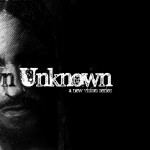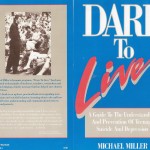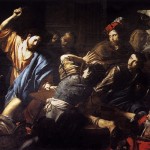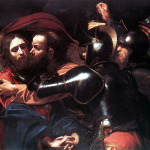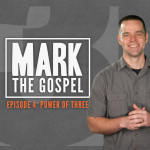Archives For Stories
Why Does Mark Link Jesus’ Baptism, Transfiguration and Crucifixion?
Repeating a pattern three times is a common storytelling technique and Mark uses it to great effect. Through it, he ties his book together and highlights his message that Jesus is the Son of God.
Have you noticed the parallels between Jesus’ baptism and transfiguration?
If you haven’t read Mark, take the next hour and read it all in one sitting, just like you’d watch a movie. Finding these parallels and patterns is just part of the fun of a good story’s game.
Let’s start with the transfiguration in chapter 9. Jesus goes up on a mountain with some of his disciples and there, his clothing begins to glow. Suddenly, Moses and Elijah appear! And the disciples are utterly terrified. Then a cloud envelops them and we hear God say, “this is my son…”
Sound familiar? Well, that’s almost identical to what we heard in Mark 1. When Jesus comes up out of the water, the heavens are torn open and God says, “You are my son…”
Do you see the others?
In both scenes, there’s a major shift in the heavens. The enveloping cloud in chapter nine and the ripped sky in chapter one.
And then there’s Elijah. He appears at the Transfiguration and yes, also in the Baptism. You might have missed this one! But Mark implicitly describes John as Elijah when he tells us that he wore a garment of hair with a leather belt around his waist. If you know the Old Testament, like Mark’s original audience, you’ll know that it’s this same description which leads a king in 2 Kings 1:8 to identify the person so dressed as Elijah.
So in the baptism and transfiguration, we have these three parallels. Elijah, Movement in the Heavens, And the identification of Jesus as God’s Son.
Pretty cool! Right?
Now think of Mark’s description of the crucifixion. Darkness covers the land! And Jesus cries out in Aramaic, “Eloi, Eloi…” which means “My God, my God…” But the bystanders think he’s calling for Elijah. Then Jesus breathes his last and the temple curtain is torn in two, from top to bottom. And the centurion remarks, “truly this man was the Son of God.”
There it is, again! The pattern is in fact repeated three times.
What’s Mark doing?
Well if you think about the whole book of Mark, you’ll remember that stories told in threes happen quite regularly. There’s Jesus’ three passion predictions, the three times he wakes his sleeping disciples, and the three times Peter denies him.
Three is huge! And not just for Mark. This is, in fact, the way we tell stories. Think of Goldilocks and the three bears (bowls, chairs, beds) or Charles Dickens Christmas Carol (Ghosts of Past, Present, Future). It’s a common literary device.
Three shows completeness. Emphasis. It’s the smallest number that forms a pattern. The first instance is chance. The second a coincidence. But three times reveals a design.
And this is what Mark is doing in some of these triads. In telling us three times, he stresses to his listening audience the disciples inability to change. And at the same time, drives home the point to his hearers. Don’t be like them! Don’t miss the point!
Mark is for sure creating emphasis in the parallels between the baptism, transfiguration, and crucifixion but he’s also at the same time doing something more.
This too is common in storytelling: because twice suggests a pattern, we naturally anticipate its continuation at the partial appearance of a third. Which allows the storyteller to hit us with the twist.
Think of the way jokes are told. Three guys walk into a bar. The first guy says something. The second guy says something similar. But the third guy takes it in a whole new direction. But the twist isn’t only found in punchlines. We find it in the third part of three little Pigs and the boy who cried wolf. We even see it in longer films like the Shawshank Redemption. Remember Red’s third parole hearing?
Mark, having built a pattern in the baptism and transfiguration, hits his audience in the crucifixion with a twist. This time, it’s not God’s voice declaring Jesus His Son. It’s a person. The first person, in fact, in of all of Mark’s story to express this idea.
Now think of the progression in these three scenes. In the baptism, it’s Jesus alone who hears God say “You are my Son.” It’s a private experience. No one else seems to know what’s going on. But in the second instance, that experience is repeated for others, God tells a few of the disciples “This is my Son.” But in the crucifixion, we find this idea finally taking hold and being repeated at last by a person. And what’s really remarkable, it’s not one of the disciples. It’s not even a Jew. he’s a Roman soldier. The enemy! The person, we least suspect. Declaring it, at the point we least suspect it.
See you next time.
Why does Mark Arrange his Stories in Patterns?
To understand Mark you have to open your ears. Mark’s arranges his stories in recognizable patterns to help a strictly listening audience hear and interpret their meaning.
Mark has this way of telling stories which appears frequently in his gospel. He begins with one story, then switches to another, before once again returning to finish the first. If you haven’t seen it yet, here’s one example:
In chapter 6, Mark recounts how Jesus instructed his disciples and sent them on a mission. He then jumps to an involved and yet seemingly unrelated flashback dealing with Herod’s beheading of John the Baptist. Only then does he return to the disciples and their mission.
This basic A-B-A pattern is known as a sandwich. And its essence can be felt in other arrangements; for instance, as we saw last time, in the bookending of Mark 8-10 with the healing of two blind men.
The sandwich is not unique to Mark. It’s a common literary device. And as such its not something Mark derived wholly from chronology. Contrary to what you might think, Mark isn’t simply telling us what happened. He’s chosen to arrange his story this way. The question is why?
Well that has a lot to do with how Mark thought his audience would receive and comprehend his book.
In Mark’s time, a book was considered differently than it is today. If you happen to look at a surviving first-century manuscript you might be surprised to find it devoid of things like chapter numbers, section titles, paragraph indentations, highlighted words. Not even punctuation or spaces between words! Today, such graphic signals are indispensable to written communication. We depend on them to orient ourselves to a books structure and point.
But ancient authors and audiences couldn’t depend on such visual signals. Before printing, the copy of books was limited. Most people simply wouldn’t see the text. Besides literacy itself was a specialized skill; maybe 2 percent of the population could read. The book, consequently, wasn’t regarded as a silent and private flow between writer and reader. Instead it was a script to extend the voice of a speaker. Authors wrote not so much to be read but heard through public reading.
Interestingly enough. Those who could read, always read out loud, even when alone. Silent reading was in fact considered something strange when it first appeared some three hundred years later.
This means that Mark told his story in such a way that a strictly listening audience could hear and comprehend it.
Think about that! You’ve never read or heard Mark and then one Sunday, your pastor opts to read the entire gospel out loud in place of a sermon. That’s a lot of events to unpack in the roughly hour and fifteen minutes it would take. How could Mark’s original audience understand it all? Could you?
Of course you could. You do it all the time. Apart from a picture, listening to Mark isn’t that much different from watching a film. Because of the limitations of our minds, storytellers have always divided longer narratives into a hierarchy of units. In movies, scenes are bundled into sequences and sequences into acts. We call this bracketing or packaging.
In modern books, the division of units is typically found in the look of the page. But in a venue without text, organization is indicated in other ways. A preacher, for instance, might offer the blatant “first point, second point, third point, and in conclusion” in his sermon. While the filmmaker divides his story through subtle repetition and parallels. As in the same crossroads in the opening and closing in the film Cast Away – There’s that Sandwich!
Like a filmmaker, Mark divides and packages his story without using graphic signals on the page. And just as in a film, he does it through in the packaging of repetition. The Sandwich’s A-B-A pattern being the most obvious example.
Ancient authors and audiences were keenly aware of the application and use of parallels for hearing a stories organization. Repetition breaks up a linear progression and creates a beat-counterbeat effect. And the principle was used in varying ways. In Mark, for instance, we find the use of an a-b-c-a-b-c pattern. Mark, for instance, links Jesus’ calming of the storm and the healing of the woman with the issue of blood in just such a pattern. We also find a symmetric a-b-c-b-a pattern, known as a chasm, at work, for instance, in the feedings of the five thousand the feeding of the four.
Knowing all this should make a difference in the way you approach a book like Mark. For starters, you should recognize that the graphic divisions in our Bibles do not indicate Mark’s structure. These divisions are a referencing tool, nothing more! You can actually misread Mark, reading it chapter by chapter. Bracketing Mark’s story in the wrong place or failing to bracket it at all distorts Mark’s meaning. Just as in Algebra, the bracketing of different equations leads to vastly different sums. Or as in Grammar where the presence or absence of a comma changes the way a sentence reads.
We need to constantly hear and consider Mark’s larger picture, even as we hear and consider each individual story. And its to that larger story we shall turn, next time.
See you then.







